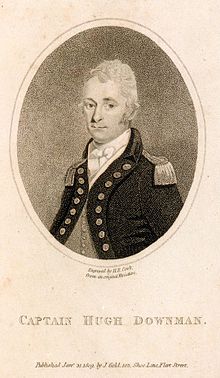Hugh Downman | |
|---|---|
 | |
| Born | c. 1765 Plympton, Devon |
| Died | 4 January 1858 Hambledon, Hampshire |
| Allegiance | United Kingdom of Great Britain and Ireland |
| Service/ | |
| Years of service | 1776 – 1858 |
| Rank | Admiral |
| Commands held | HMS Speedy HMS Santa Dorothea HMS Caesar HMS Diomede HMS Diadem HMS Princess Carolina HMS Windsor Castle |
| Battles/wars | |
Hugh Downman (c. 1765 – 4 January 1858) was an officer of the Royal Navy who saw service during the American War of Independence and the French Revolutionary and Napoleonic Wars, eventually rising to the rank of admiral.
Downman spent most of the American War of Independence as a midshipman, with a spell in French captivity after his ship was wrecked off the coast of Ushant while chasing an enemy frigate. He was promoted to lieutenant shortly before the outbreak of the French Revolutionary Wars and served with distinction during operations in the Mediterranean. Downman served under several Admirals, and fought with Jervis at Battle of Cape St Vincent. Shortly after the battle he was rewarded with his own command, going on to capture several privateers and fighting off an attack by a larger vessel. Promoted to post-captain and given a frigate to command, he operated in the Mediterranean and performed services for the nobles and monarchs of the Italian states. Downman went on to command several ships of the line, often as a flag-captain, and took part in the capture of the Cape Colony and operations on the Río de la Plata.
Left without active employment after the end of the wars with France, he briefly returned to service in 1824. before being promoted to flag rank the following year. Downman continued to rise through the ranks, reaching the rank of full admiral before his death in 1858.
